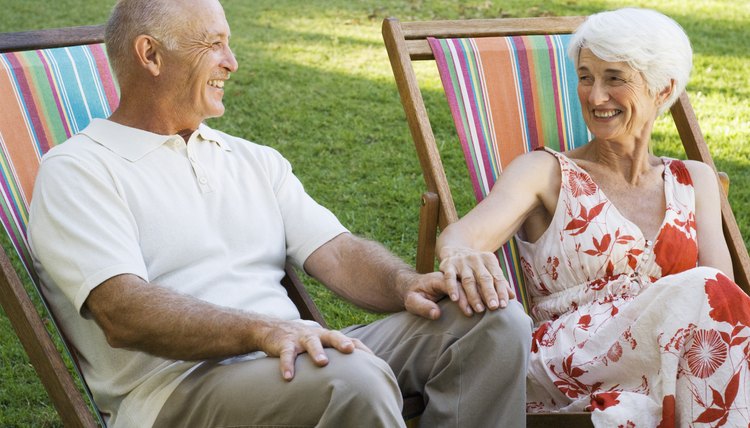Strengthening Exercise for Difficulty Rising From a Chair

To improve your ability to get in and out of chairs, cars and other seating, you’ll need to build strength in your calves, hamstrings, quadriceps, hips and core. This won’t be difficult if you start slowly and increase your resistance as you build strength. You’ll be able to perform many of these exercises with little or no equipment, while sitting in a chair.
Strength Exercises
To build strength, use an amount of weight or resistance that lets you perform 10 to 15 repetitions of an exercise, with the last few reps difficult to finish. Use dumbbells, resistance bands or your body’s weight to create resistance. Perform the exercises quickly the first week you start exercising to make them easier and let your muscles get used to the new movements. After several workouts, begin performing the exercises slowly, using muscular effort to raise and lower weights or your body instead of letting weights or your body drop back down after you move upward.
Heel Raises
Your calves assist your legs in raising you out of a chair. Start to build their strength with an easy exercise that requires no equipment. Stand about half an arm’s length from a wall so you can lean against it if you lose your balance. Stand with your feet about shoulder-width apart, then raise yourself onto your toes. Hold this position for at least 10 seconds, then slowly lower yourself. Repeat this 10 times and perform the exercise three times each day. Hold dumbbells or 1-gallon milk jugs filled with water to help build more muscle.
Walking Stairs
Walking up stairs helps work your calves, hamstrings, hips and butt, while walking down stairs emphasizes your quadriceps. Walk up and down stairs slowly to build muscle, eventually taking stairs two at a time if you’re able. Use a staircase that has a handrail so you can grab it if you fatigue or lose your balance.
Russian Twist
Getting out of different types of seating often requires a core turn to assist you, such as when you get out of a car or up from a sofa or a low chair with a cushion. Work your obliques, located on the sides of your stomach, with exercises that turn you side to side. Sitting in a chair, hold an object that weighs at least 2 or 3 pounds at arm's length. Turn to the right slowly, using your core to turn you, rather than your shoulders. Pause for two seconds and then turn back to center. Pause for two seconds and turn to the left. Repeat this exercise for 30 to 60 seconds or until you begin to fatigue. Practice turning by using your shoulders and using your core muscles to learn the difference so you can avoid the shoulder method.
Leg Lifts
Another way to work your core muscles is to target your rectus abdominis, or the central stomach muscles that make up a “six pack,” with exercises that create a forward and backward motion. A simple way to do this is to do leg lifts while sitting in a chair. Straighten your legs in front of you and lift them slowly. Hold in this position for as long as you can without straining your back, then lower them. Add weights to your ankles to increase your benefit.
Leg Presses
Your large quadriceps muscles are integral to helping you get out of a chair. Work them using resistance bands while sitting in a chair. Put your feet into the bands and raise one knee to your chest. Wrap the resistance band tightly and then slowly straighten your leg, pushing against the band. Pause and then return to your bent-knee starting position. Repeat with the other leg. Vary the exercise by using both legs at once or by performing it from a standing position.
Another way to work all of your muscles at once is by stepping up and down on the bottom stair of a staircase or other low platform. Step onto the stair with one foot, then the other. Alternate your feet to create a marching movement. Stand on your toe after each step-up to include calf-strengthening heel raises. Alternate the exercise by stepping up with one leg, keeping the other foot off the ground until you step back down.
References
Writer Bio
Sam Ashe-Edmunds has been writing and lecturing for decades. He has worked in the corporate and nonprofit arenas as a C-Suite executive, serving on several nonprofit boards. He is an internationally traveled sport science writer and lecturer. He has been published in print publications such as Entrepreneur, Tennis, SI for Kids, Chicago Tribune, Sacramento Bee, and on websites such Smart-Healthy-Living.net, SmartyCents and Youthletic. Edmunds has a bachelor's degree in journalism.
